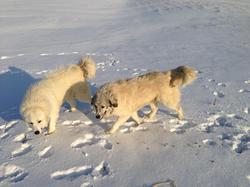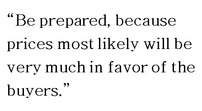Uptown Girl
Christian. BoyMom. Farmer's Wife. Marathon Runner. Ag Professional. Bourbon Lover.
Advocate for all things agriculture and rural.
Advocate for all things agriculture and rural.
 This is the time of year we start getting questioned about when we will bring our big white dogs inside, and why our dogs are laying out in the middle of a snow pile and not in the barn. And it’s not just from non-farm folks either. In fact, I find myself displacing some of the below myths on Great Pyrenees (and other working dogs) all the time to all sorts of people! So, what are the biggest Livestock Guardian Dog (LGD) myths out there? 1. LGD’s are pets! So this is only a half myth because about 30% of our pups are actually sold very successfully as companion only dogs and their families LOVE them! But, our main purpose in having and raising dogs is raising LGD's and these dogs are NOT pets! They have a very serious job to do and they know it. They are no interested in spending much time with you or I, they are not interested in sitting or rolling over and they certainly are not interested in leaving their stock at night to come into the house. 2. They are cold! They are not cold! Our dogs, Great Pyrenees, actually have been bred to live outside because generally speaking that is where their stock live (although nothing surprises me anymore). They are equipped with a double coat that insulates them in sub-freezing temperatures, blocks wind, and catches rain and ice on the outside of their coat (away from the skin). Although all of our dogs have access to barns, it’s rare for them to spend much time inside at all. They cannot hear, see and sense their surroundings as well inside and whenever they lose that control, their anxiety kicks in. So that is why you see them lying outside. 3. Neutering a dog will ruin his ability to work! Wrong! Neutering (spaying) a dog will only ruin his ability to do one thing—reproduce. Actually, dogs that are fixed as close to 6 months as possible are the most effective working dogs out there. Their mind is always 100% in the game, instead of the female in heat who has stronger urges for 3 weeks out of the year than guarding her stock. And believe me, you don’t want a female in heat at the peak of lambing, in the dead of winter when your neighborhood coyotes are hungry. A male Pyrenees will take off to find females to breed and can sense them from miles away. And guess what else is in the dog family? Coyotes and wolves. It’ll be best for all involved if your LGD doesn’t bed down with the enemy so GET YOUR DOGS FIXED! 4. An older LGD is already “trained”! Be cautious of moving older dogs and certainly do not pay more money for one because she has “learned from Mom and Dad”. What she has done is bonded with the farm and stock where she was born, making it harder to move her and harder to create a bond with your stock. Pups are best placed between 8 – 16 weeks (for Great Pyrenees, as this actually does vary greatly from breed to breed. Many breeds of LGD require more supervision and guidance to develop into ideal guards so speak to your breeder). Older dogs can, and do work. But just be aware that you are not buying a fool proof system. 5. He came from “working lines”. My least favorite, most hated line regarding livestock guardian dogs is “working lines” when someone is a attempting to explain why they are selling working dogs who have never so much as smelled a sheep. WORKING DOGS COME FROM WORKING PARENTS. Not working grandparents. Or working uncles. Or working cousins. WORKING PARENTS. Everyone knows someone who found this great dog at a shelter, or a litter in downtown LA and came home to be the best LGD ever. This is the exception, not the rule. If you need a real working dog to protect the equity in your stock, please buy a dog from a farm, who is outside with the stock and has always been outside with the stock.
10 Comments
 As I prepare for the dispersal sale, we have had a lot of questions come up about sorting through the 100+ head we will be offering. I remind buyers that our sale, like many dispersals, is putting a lot of animals onto the market at a single time. Be prepared, because prices most likely will be very much in favor of the buyers. Sorting through a dispersal sale can be an overwhelming task, but one that can be made more manageable by following some of these tips from industry experts: 1. UNDERSTAND THE BREEDER!! Club calf breeder Joe Basinger points out, “Know the reputation of the breeder and their animals. Do a little research of what works for them, and see if it lines up with your own personal goals for your program”. Sheep industry expert Mark Johnson reminds buyers to shop dispersal sales where ALL animals are selling, and to avoid ‘house cleaning’ sales, where just a few of the bottom end animals may sell. 2. ITS ALL ABOUT THE....FEMALES!! The key to most successful programs lies in managing ewe families. Figure out which ewe families will work for your program, and find as many sisters and daughters in that line as you can. Many experts suggest focusing on one or two lines, and purchasing as many females from those as you can. On older ewes, producer Eric Shellhouse suggests, “Ignore the picture and look at how they performed. Often it’s the ugly twin sister of a show ewe that performs.” Johnson suggests, “Look for awesome young sheep and [then] find their mothers and sisters.” 3. LET AGE BE AN INDICATOR!! The best producers are only keeping animals around that are paying for themselves. The older females are still there for a reason, most likely having successfully produced for multiple years. Additionally, older animals have animals on the ground you can analyze. There is less risk involved in trying to guess how these females will work. To many breeders, the highlight of a production sale is finally getting the opportunity to own those females that, in normal circumstances, would never, ever be made available – for any price. Basinger says, “I don’t have a particular age of a female that I target. If they are good and they produce, they are worth trying.” However, as Shellhouse points out, “Unless you plan to flush, be realistic about how many lamb crops a 6-year old has left.” And Basinger reminds buyers, “It’s important to set a limit on how much you will spend on older [females]. Reality might be that you only get a couple of years out of them with their age.” But experts note, it only takes one season for a good female to produce that next top stud. Johnson suggests analyzing younger females, specifically ewe lambs for several reasons. “I prefer to add ewe lambs. It gives them time to adapt to a new climate and management practices before being asked to produce.” 4. DON’T MISS THE STUDS! A dispersal sale also offers a great opportunity to purchase full or partial interests in stud power that would normally not be available. “Proven rams can be a great asset,” says Johnson. In a dispersal sale, you have the chance to purchase the stud power they were actually using. Most people come to dispersal sales after females, which often means that the bucks can be purchased at a discount. 5. USE ALL YOUR TOOLS!! Johnson reminds us to “Always use all of the tools as your disposal” when making purchasing decisions from a dispersal sale. Analyze production records and, possibly most important of all, talk to the producer! Basinger says, “I always believe in analyzing on phenotype and genetics combined. In our world, there are certain pedigrees that work really well for producing certain types and you need to know what those pedigrees are.” |
Uptown GirlKate Lambert grew up in northern Illinois, not on a farm but active in FFA and showing livestock. Archives
September 2022
CategoriesAll Ag Industry Conservation Cooking Cover Crops Crop Farming Farmer's Wife Farm Takeover Fertilizers Food Safety Gardening GMOs Hunting And Fishing Lamb Livestock Local Farmers Modern Farming Mom #My60Acres Parenting Politics Pumpkin Recipes Recipes Running Rural Lifestyle Sheep Showing Livestock Sunday Struggles #SustainabilitySundays #UptownUploads |
Stock
|
The Farm
|
|